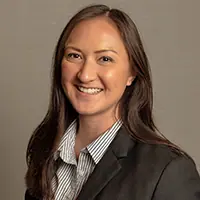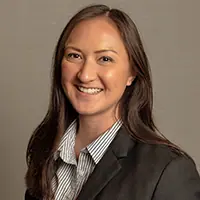Kiah Lau Haslett is the Banking & Fintech Editor for Bank Director. Kiah is responsible for editing web content and works with other members of the editorial team to produce articles featured online and published in the magazine. Her areas of focus include bank accounting policy, operations, strategy, and trends in mergers and acquisitions.

Bank OZK Profits From Banking’s Siren Song
There is perhaps no midsized bank in the United States managing credit risk as publicly as Bank OZK.
The $36.8 billion bank is in Little Rock, Arkansas, but it finances projects that shape the skylines of major cities across the U.S.: Luxury apartments, condo buildings, new office complexes and skyscrapers. It is no stranger to construction and development loans, having lent to the space for decades through numerous economic cycles. It is this business line that has driven its historic profitability, and it is this business line that critics say generates outsized credit risk. While this criticism is nothing new, the current macroeconomic environment poses a formidable challenge to the bank’s ability to manage risk.
Bank OZK would not take all this risk if it was not lucrative. Its return on average assets in 2023 hit 2.28%, aided by a net interest margin of 5.16%, and its efficiency ratio was 33.70%. Bank OZK tied for 16th in overall financial performance in Bank Director’s 2024 RankingBanking analysis of the 300 largest publicly traded banks and was ninth in the category of banks with between $5 billion and $50 billion in assets. The ranking uses 2023 financial metrics regarding capital adequacy, credit quality and profitability, and is more heavily weighted toward profitability.
The source of Bank OZK’s profits — and controversy — comes from its real estate specialties group, or RESG, a national leader in commercial real estate construction and development finance.
“They’re really big, chunky loans,” says Benjamin Gerlinger, vice president of equity research, regional banks, at Citigroup. “They’re construction development loans, which are much, much larger than any bank with a [similarly] sized balance sheet would take.”
Gerlinger points out that the asset class carries the notoriety of being one of the worst credit performers in an economic downturn. Commercial real estate can become a siren song for banks, which are active in the space but often succumb to the temptation to grow through unmanaged risk that becomes evident in a downturn. Construction is seen as an especially risky area of CRE. Risk factors in this space include highly leveraged transactions and long credit gestation periods that are vulnerable to changes in supply and demand market dynamics. These transactions sometimes are structured in a way that shields the group behind a construction project from default risk, and a bank may finance them outside of its market area and geographic expertise, according to the Federal Deposit Insurance Corp.’s 2023 Supervisory Insights that builds on regulators’ 2006 guidance on managing CRE risk.
Growing “Like a Weed”
That 2006 interagency guidance was seminal for the industry because it established two key thresholds for bank CRE concentration risk: A bank has a CRE concentration if construction, land development and other land loans equal 100% of total risk-based capital. In addition, a bank can be classified as CRE-heavy if the bank has multifamily, construction and nonfarm, nonresidential property loans that reach 300% of total risk-based capital, and those loans grow by at least 50% in the prior 36 months. By comparison, CRE loans represented 455% of Bank OZK’s tangible common equity at the end of the first quarter. When including unfunded commitments in total CRE exposure, the percentage is “nearly twice that amount,” according to a June 6 report from Moody’s Ratings.
The RESG segment has grown “like a weed” as the bank has gotten bigger, says Gerlinger. The risk now, he and others believe, is that multiyear construction projects that started in a zero-rate environment will not fare well in a 5%-plus rate environment, and that office buildings will fail to attract the same rent as workforce habits change or the economy slows down. But the developers — and the bank behind them — are still under pressure to finish partially constructed buildings even as demand changes.
Gerlinger became the face of the Bank OZK critics when he published an analyst report downgrading the firm on May 29 due to “substantial concerns” about two of the bank’s projects, including what he believes is its largest individual loan. The downgrade led to a 15% selloff in the bank’s stock that same day, dropping to $39.60 — a price close to Gerlinger’s price target of $37.00. Bank OZK’s share price has recovered, to $47.08 as of July 30, and is higher than its second quarter 2024 tangible book value of $38.85 per common share. Gerlinger thinks the lower price target is “appropriate for the amount of risk that they’re taking because it implies that earnings are at risk, but maybe not capital.”
“From an operational perspective, I believe that they are solid operators, don’t get me wrong,” he adds. “But I also believe that they’ve taken a tremendous amount of risk and the market’s moved on them, and they are forced to keep it because the construction loan can’t stop the moment the shovel hits the ground.”
Mitigating Risk
George Gleason II, the bank’s chairman and CEO, is familiar with this criticism and CRE risk. He thinks the bank can manage it and still succeed in this environment. (Bank Director interviewed Gleason prior to Gerlinger’s report publication; the bank declined to comment.)
“Risk management permeates our culture,” Gleason says. Everybody “realizes they’ve got to be a risk manager. If they’re touching things that have credit risk, if they’re touching things with interest rate risk or reputational risk, or any of the legions of risk that a company our size faces, everything’s got to be focused and attentive to that all the time.”
To start, Bank OZK doesn’t generalize: It doesn’t make an RESG loan just because it’s in a certain metro area or because it’s a certain type of commercial building. Instead, it looks at each project on an “asset-by-asset” basis against the project’s submarkets and the supply-demand metrics, he says. The bank also works with high-quality sponsors who have big, liquid balance sheets backing up their projects and the relevant expertise and skills to execute well on their proposals.
“Sponsorship is just critical. You like having veteran sponsorship that’s been through a bunch of cycles,” he says. “In an environment like we are in now, they don’t panic, they recognize the challenges they face, and they’ve got a playbook from experience about how to solve those challenges, address the issues and turn them into opportunities.”
Bank OZK also participates as a senior secured lender in selected projects that already have a lot of equity, Gleason says. The sponsor puts in all their equity before the bank funds; the bank is the first to be paid in a payoff. The weighted average loan to cost for the entire RESG portfolio at the end of 2023 was 52%, and the weighted average loan to appraised value was 43%.
“There are a thousand details that go into having a properly structured transaction, but they all boil down to the fact that you want equity to be taking equity risk at every point,” Gleason says. “And as a senior secured lender, you never want to take equity risk.”
Protecting the Bank
That underwriting discipline has protected the bank, especially as predecessors and competitors have blown up, says Sam Haskell, founder of investment management firm Colarion Partners and publisher of the “Five Points” bank investing newsletter. He says the underwriting approach, plus deep familiarity with the “tricks” that developers use, gives the bank a preferential position in the capital stack of these projects.
“I’m not sure it matters if it’s a high-rise office or Pokémon cards: If you’re the last 40% in, you’re privileged, and that is a very strong position to start from,” he says. “The project actually has to be destroyed within about three years for you to end up losing money.”
Developers like working with Bank OZK on the select projects it funds, says Stephen Scouten, a managing director and senior research analyst at Piper Sandler & Co. Among developers, there’s a sense that if the bank can make a loan work on a prudent, risk-adjusted return, it will. If it can’t, then probably no one can do it. The bank prides itself on being easy to work with but is diligent when it comes to collateral quality, thorough documentation and the transaction structure.
“They’re very serious about their loan documentation — hiring hordes of attorneys — to make that process quick and as easy as possible if a loan does go bad, so they can work it out, flip it to another developer or sell it quickly,” he says.
Haskell adds that Bank OZK services loans “pretty aggressively.” He has heard stories of bank personnel monitoring the pace and cost of the project it funds, sometimes knowing sooner than the developer if a permit needs to be renewed or there are delays.
A Nearly Empty Building
All that could come to a head in the bank’s largest project, a life sciences tower in San Diego, dubbed the “Research and Development District” that triggered Gerlinger’s downgrade. Gerlinger visits San Diego annually to take his son to the zoo and has seen this particular building under construction for years.
He found the agreement for the 1.7 million square foot commercial building by cross-referencing the bank’s disclosures to county records tied to new building construction. He discovered the property has had minimal leasing activity and lacks a major life sciences tenant.
The project’s sponsors brought new capital to the deal as part of a scheduled replenishment, according to the bank’s second quarter earnings. The additional capital lowers the project’s loan to cost to 47.1%, assuming it is fully funded. The project’s sponsors negotiated an additional two-year extension option as part of that capital contribution and a longer-than-expected leasing cycle, according to bank management comments.
The total loan commitment is $915 million, with the unfunded balance at the end of May totaling $360 million, the “majority of which is designated for ‘good news funding’ (tenant improvements and leasing commissions),” the bank stated in a Form 8-K released after Gerlinger’s report.
While construction lending has been historically risky for banks because it lacks a source of income compared to cash flows on existing buildings, it’s performing better than some other types of CRE in the current environment, says David Fanger, senior vice president and manager of the financial institutions group at Moody’s Ratings.
The difference today, he says, is that the economy remains relatively healthy, and recession risk seems low, creating demand for new construction. These loans usually carry a higher, floating rate compared to a traditional fixed rate CRE loan. Developers still have incentives to lease up the new building and refinance the loan, and may be able to obtain lower rates on the traditional CRE loan than their construction loan.
RESG loans are predominately variable rate — and that could be a good or a bad thing. Gerlinger believes the changes in the interest rate and office environments have been so rapid that there is a rising risk of default, despite OZK’s long track record of low losses, and that the bank’s provisioning “needs to go up pretty dramatically to account for these vacant buildings.”
Asset Quality so Far
Bank OZK’s asset quality has held up so far. The industry’s quarterly net charge-off rate was 0.65% in the first quarter of 2024, according to the latest FDIC’s Quarterly Banking Profile. In contrast, Bank OZK’s second quarter annualized net charge-off ratio to average total loans was 0.17%. Other loss ratios are similarly low.
Those credit quality figures could be interpreted as a sign of under-reserving or as a sign of disciplined credit underwriting. In contrast to the pessimism of Citi’s Gerlinger, Scouten has had an “overweight” stock rating on the firm for “years” to indicate his belief that the stock should outperform its industry in the broader market. He says the bank is easy to misunderstand, especially for investors who don’t specialize in banking and are looking for “easy stocks” to short.
“They’re really good underwriters, and they have had better credit for the 14 years I’ve covered [banks] than anybody else,” he says.
Gleason says OZK’s balance sheet has been designed to manage stressors that come from rate movements, and that an expanding margin and record profitability have helped the bank afford higher credit costs ahead of anticipated losses. The bank also uses stress testing to inform its strategy and drive adjustments. It tests its CRE portfolio and liquidity quarterly and capital annually, each using multiple scenarios. Gleason wants to make sure the bank can survive the scenarios, some of which are “very adverse and very complex.”
“We’re thinking all the time about, ‘what adjustments and tweaks can we do to manage that risk?’” later adding: “It’s our responsibility to manage our credit portfolio in a way that it performs relatively well in all economic scenarios.”
The bank also maintains relatively high capital levels: Its tangible common equity to tangible assets was 12.33% in 2023, according to Bank Director’s RankingBanking analysis. High capital levels help the bank support the extended nature of the real estate development loans as more of a project becomes funded.
Moving Beyond Construction and Development
And although RESG is the bank’s moneymaker, management is still cultivating other lending lines to service clients and diversify earnings. Bank OZK is actively hiring veteran bankers to staff up and grow its community banking and corporate and business specialties groups. The idea is to take the same talent approach, performance standards and credit culture that has made Bank OZK so successful in RESG and apply it to other credit verticals. Still, the revenues from these groups pale in comparison to RESG.
“We have consistently and repeatedly said that we want to let RESG be as big as it can be, while maintaining the discipline and the standards, practices and processes that we have put around that,” Gleason says, making it clear that the bank is not pulling back from its commitment to the space.
Proponents say Gleason himself is another advantage the bank enjoys. Haskell spent some time with him and his management team on investor road shows while Haskell worked at the brokerage firm Sterne Agee, prior to starting Colarion in 2016. He says Gleason thinks like a portfolio manager and that his thought process is “worthy of respect” from both admirers and critics.
“That sort of approach in banking draws a lot on cognitive ability and a willingness and ability to understand complex situations,” he says. “I think a bunch of people would agree with me here, you want Gleason doing that. You don’t necessarily want guys who come up the ranks from business school.”
Piper Sandler’s Scouten saw Gleason’s portfolio management approach when Gleason personally managed the book of assets that Bank OZK acquired in FDIC-assisted deals. He recalls that Gleason knew the details of hundreds of these credits. “The guy’s mind is insane,” he says.
Gleason doesn’t have a target asset size in mind for Bank OZK, which falls squarely within the regional bank space and misses the heightened scrutiny that regulators apply to bigger banks. There have been years when the bank hasn’t grown because competition pulled pricing to levels below the bank’s standards. And there are times when the rest of industry has pulled back, nursing wounds inflicted during more exuberant times or rebuilding capital — that’s when Bank OZK likes to pick up activity from qualified borrowers looking for a bank that will work with them.
2024 may be one such environment. While there are still banks competing against Bank OZK, others have pulled back due to earnings weakness, interest rate risk, credit issues or low capital levels.
The Naysayers
Gleason knows regulators, short sellers and the industry are watching Bank OZK to see if it can continue dodging the shortfalls that have befallen hundreds of banks before it. Scouten, for his part, understands why people are negative on the bank after all this time, even if they’ve been repeatedly proven wrong. He just thinks they should consider updating their thesis.
“It’s been the same thesis for seven years now,” he says. “At some point, you just have to give credit to the management team that they’ll continue to do the things that drive profitability.”
Bank OZK sets itself apart in the industry as one of the most active managers of the risks it takes — and makes money for doing it. It does this in the face of skepticism that these risks can be managed or that the bank is managing them as well as it says it is.
“We try to let extraneous things be extraneous things,” Gleason says. “We focus on our business and our customers. … If you take care of your customers, you’re going to put up good results. If you put up good results, you’re going to take care of your shareholders. So, if people are crazy on the short side for a little while and have a negative thesis, that’s on them. Just keep producing, keep delivering the results, and you win in the long run.”



